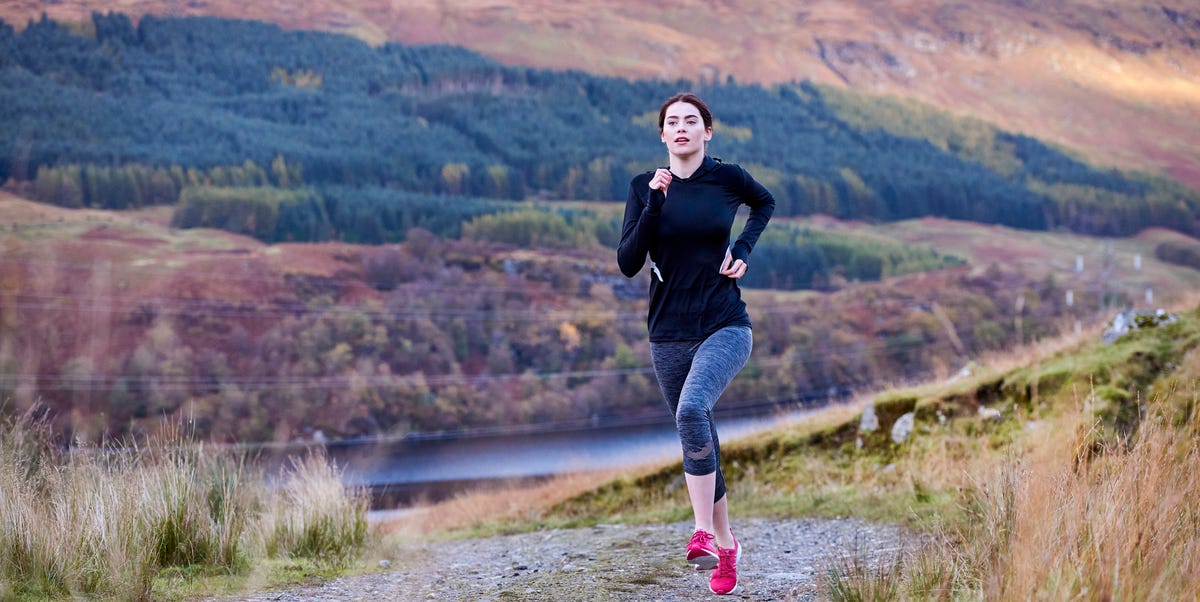Whether you’re pounding the pavements or hitting the trails, running rarely happens on a perfectly flat surface. From rolling inclines to steep climbs, different terrains challenge different muscle groups — and your body responds accordingly. Take downhill running, for example: it puts more demand on your calves, quads and knees, helping build control and improve your natural shock absorption.
The same goes for uphill efforts. ‘Several different muscle groups work harder than they do when running on even surfaces,’ says PT and physiotherapist Dr Kaylee Kuzma. Here, she breaks down the four key muscle groups that fire up on climbs, along with targeted exercises to strengthen them – and, in her words, ‘make hills feel effortless!’
Expect single-leg movements designed to mimic your running stride, while building balance, coordination and the kind of explosive strength that powers you uphill with confidence.
The best exercises to make uphill running easier1/ Single-leg hip thrust 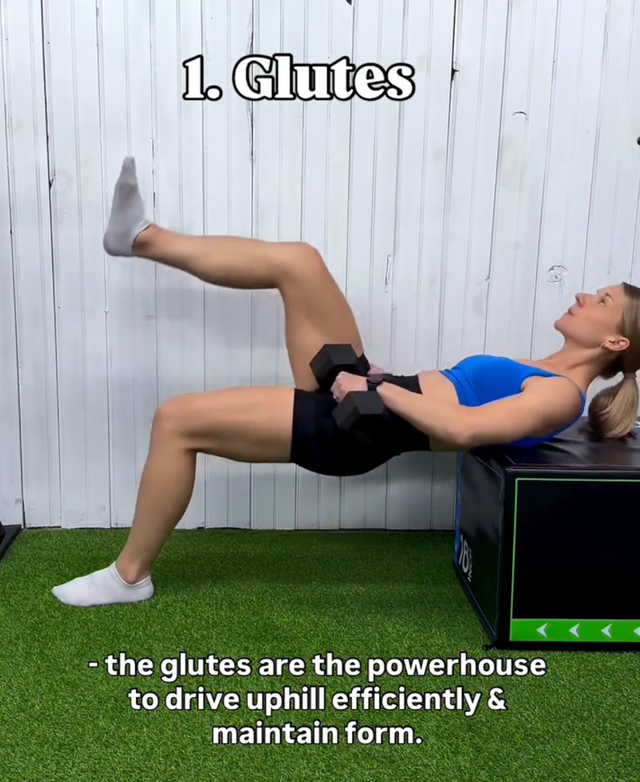
@dr.kayleekuzma_dpt//Instagram
Muscles strengthened: Glutes
Want to power up hills more efficiently? Start here. The single-leg hip thrust helps you build unilateral glute strength – key for running uphill with control and power.
‘Your glutes are the powerhouse to help you drive up efficiently and maintain form,’ says Dr Kuzma. These muscles (your hip extensors) do the heavy lifting when it comes to driving you up an incline while also supporting your running posture.
How to do the move:
Sit on the floor with your shoulder blades against a bench or box. Bend one leg to about 90 degrees, placing its foot on the floor. Lift your other leg. If you’re new to the exercise, start with just your bodyweight. Otherwise you can balance a dumbbell on the hip of your working legKeeping your chin tucked in, push up through your hip to lift your hips off the floor, contracting your glute.Squeeze your glute at the top – your shoulders, hips and knees should be in a straight line, without an arch in your lower back.Lower back down in a slow, controlled movement.2/ Single-leg stability ball hamstring curl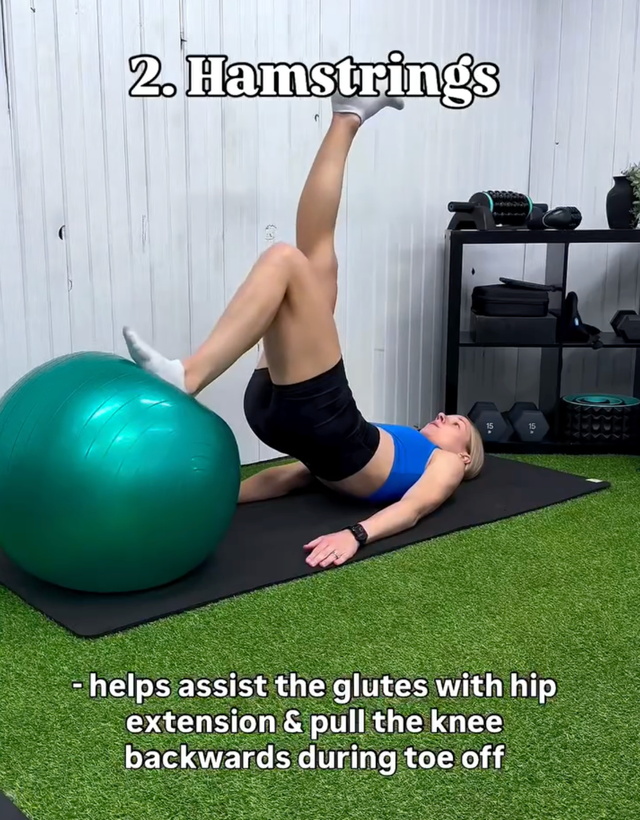
@dr.kayleekuzma_dpt//Instagram
Muscles strengthened: Hamstrings
This stability ball move isolates your hamstrings and mimics the push-off mechanics of running – making it ideal for building the strength and control needed for uphill efforts.
‘Your hamstrings flex your knee, pulling it backwards, and extend your hip, which help with the push-off and toe-off phases of running (when your foot leaves the ground to drive your body forward),’ says Dr Kuzma.
How to do the move:
Lying face up, rest your heels on top of a stability ball, keeping your legs bent. Press through your heels to raise your hips off the ground. Lift one leg straight up into the air and push your other heel into the stability ball. Slowly straighten your leg on the ball, pushing the ball away, until your body is in a straight line. At the same time, drive your hips into the air and keep your other leg straight above you. Then pull your working heel in towards your body, rolling the ball towards you. 3/ Single-leg banded knee drive with step-back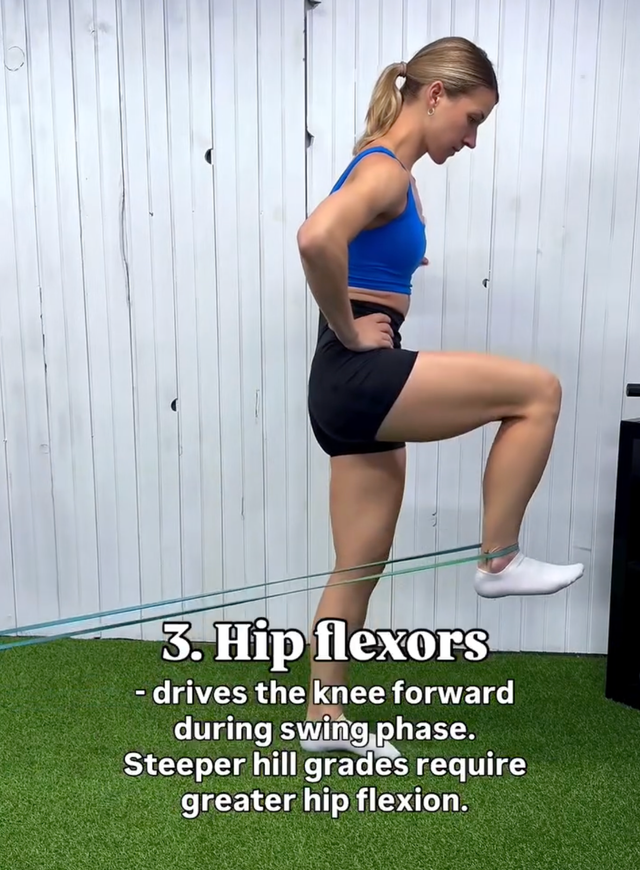
@dr.kayleekuzma_dpt//Instagram
Muscles strengthened: Hip flexors
This dynamic resistance move builds explosive power in your hip flexors – the muscles responsible for driving your knee forward when running uphill.
‘When running uphill, we require greater activation from your hip flexors to drive the knees up towards our chest,’ notes Dr Kuzma. As a reminder, your hip flexors are a group of muscles at the front of your hip that help to bring your knees closer to your chest. They include muscles like your psoas major, rectus femoris and iliacus.
Your hip flexors drive your knee forward during the swing phase, which starts when your foot leaves the ground (toe-off) and ends when your foot makes contact with the ground again (heel strike), she continues. ‘Steeper hill gradients require greater hip flexion.’
How to do the move:
Attach a resistance band at ankle level to a stable object like a rack or frame. Step into the band with one foot so that it is around your ankle.Stand tall with feet about hip-width apart, your banded leg softly bent and your other foot firmly on the floor. If you need, place your hands on your hips for added stability.Step your banded leg back two to three feet behind you, bending your supporting knee slightly, as if performing a partial lunge.Then drive your knee explosively towards your chest, engaging your core and straightening your supporting leg. Aim for your thigh to be parallel to the floor. Slowly lower your banded leg back to the starting position with control. 4/ Single-leg weighted knee drive with calf raise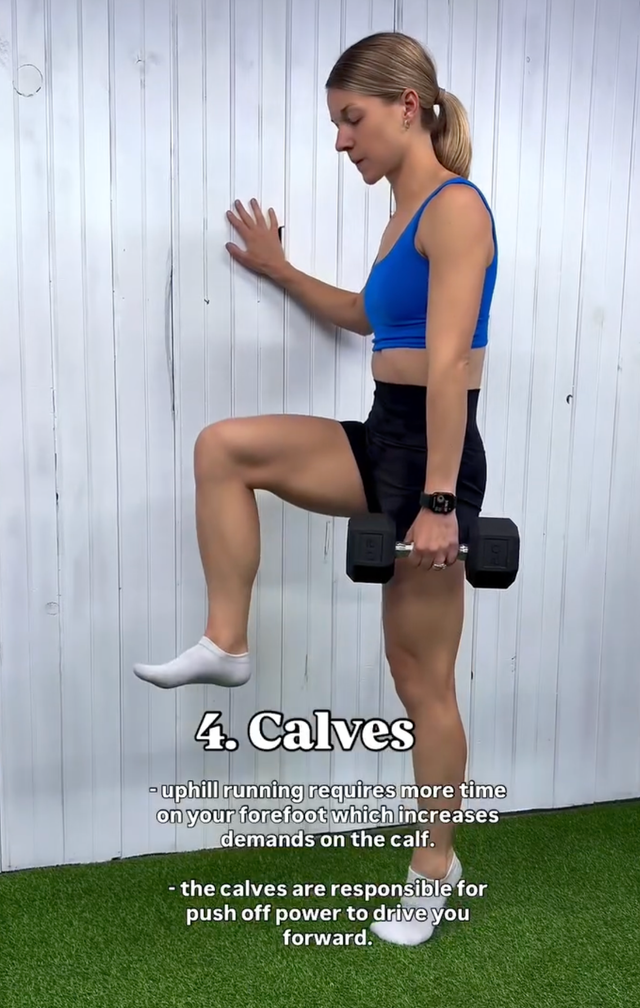
@dr.kayleekuzma_dpt//Instagram
Muscles strengthened: Calves
This move combines explosive drive with lower-leg strength, targeting the calves – key for generating power during uphill running.
During uphill efforts, your calves are doing more than usual. You spend more time on your forefoot and need extra strength to push off the ground effectively. ‘This increases demands on your calves as they are responsible for push-off power,’ says Dr Kuzma.
How to do the move:
Stand with feet about hip-width apart, holding a dumbbell in your left hand. Hold onto a wall, door or frame with the other hand for support.Step your right leg two to three feet behind you into a partial lunge, bending your supporting left knee slightly. Then, drive your right knee up toward your chest explosively until your thigh is parallel to the floor. At the top of the drive, perform a calf raise on your standing leg, which should be straight.Pause for one second at the top, then lower both your leg and foot with control. Related Stories

